Sweet Shortcrust Pastry (pâte brisée sucrée)
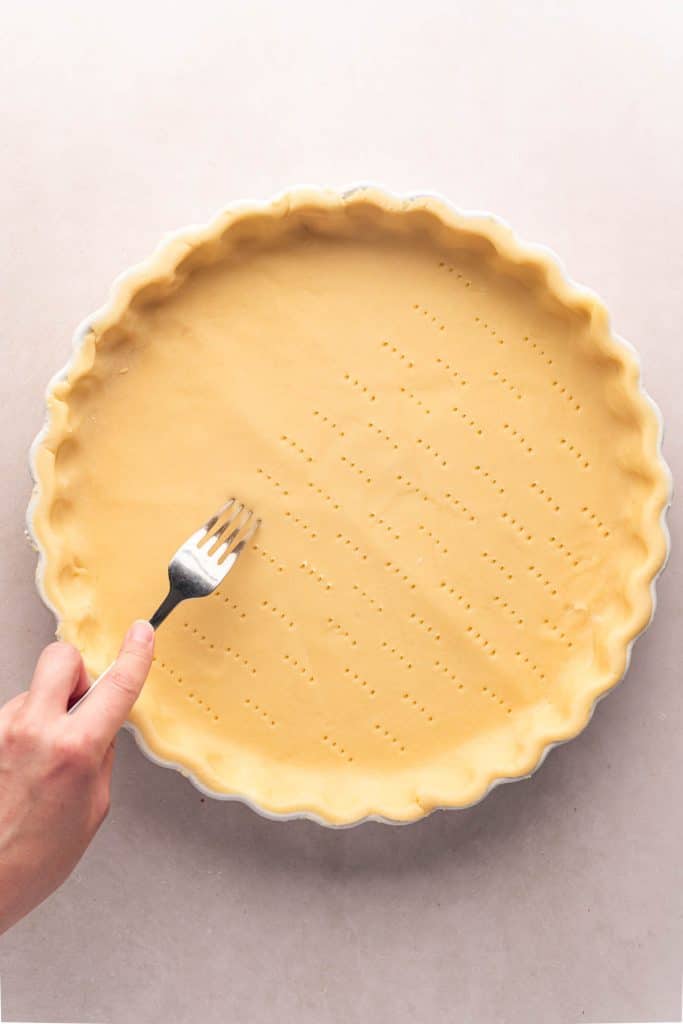
This sweet shortcrust pastry or pâte brisée sucrée is my favorite tart crust, especially for stone fruits (apricots, peaches, plums) as it holds together well. The best part is that you can make it in advance and even keep it in the freezer.
Table of Content
NOTE: This sweet shortcrust pastry differs from Pâte sucrée or pâte sablée which are made with more sugar and an egg. For pâte sucrée, part of the flour is replaced with ground almonds. These pastries, which are more crumbly and sweet, are used as bases for berry tarts.
For more French pastry classics, check out my savory shortcrust pastry recipe (basic recipe for a quiche crust). For other tart recipes ideas try my apricot with almond cream!
List of Ingredients
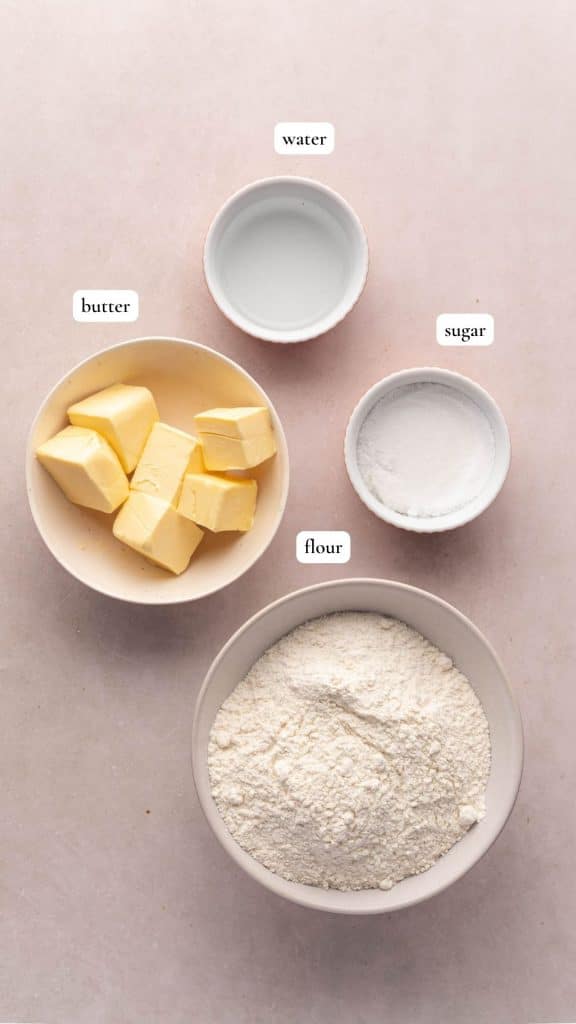
- Flour: All-purpose flour is all you need for this easy sweet shortcrust pastry recipe. For best results, sieve any lumps out.
- Butter: You need to use cold butter in your pastry. The butter shouldn’t be soft and melted. Unsalted butter is preferable.
- Sugar: I recommend using regular white or granulated sugar as is typically used. Caster sugar can also be used, but it will be sweeter.
- Water: This recipe needs chilled water. Alternatively, a whole egg can be used.
How to Make a Sweet Shortcrust Pastry?
- Make the dough. To make your own sweet shortcrust pastry, combine flour and sugar in a large bowl. Cut the butter into small pieces and add to the bowl. Blend the butter into the flour mixture using your fingers until the dough resembles coarse sand. Gradually add cold water, a little at a time, while mixing until the dough holds together. If you use a food processor, you can add all ingredients at once and mix on middle speed for 3-5 minutes.
- Rest. Form into a ball. Wrap your homemade pastry in cling film. Let the dough rest for at least 30 minutes or place in the freezer for 10-15 minutes to firm up and become easier to handle.
- Line the tart case: Preheat your oven to 180°C (350 °F). Roll out the dough on a lightly floured surface to fit the desired tart pan or tartelette mold. Carefully transfer the rolled-out dough to the greased, parchment-lined tin, pressing gently into the bottom and sides.
- Rest again (optional). If you feel your dough is warm and not easy to work with, rest it for another 10-15 minutes in the freezer or 30 minutes to 1 hour in the fridge. It will prevent the dough from shrinking in the oven. Prick the dough with a fork. Using a rolling pin or a sharp knife, trim off any excess dough from the edges of the dish.
- Blind bake the pastry. Cover the tart shell with parchment paper and fill it with pie weights, dried beans, or uncooked rice to prevent it from puffing up during blind baking. Bake the pastry case in the preheated oven for 10-15 minutes. Remove parchment paper and weights. Leave to rest on a wire rack while you prepare the rest of the fruit tart.
Step-by-Step in pictures


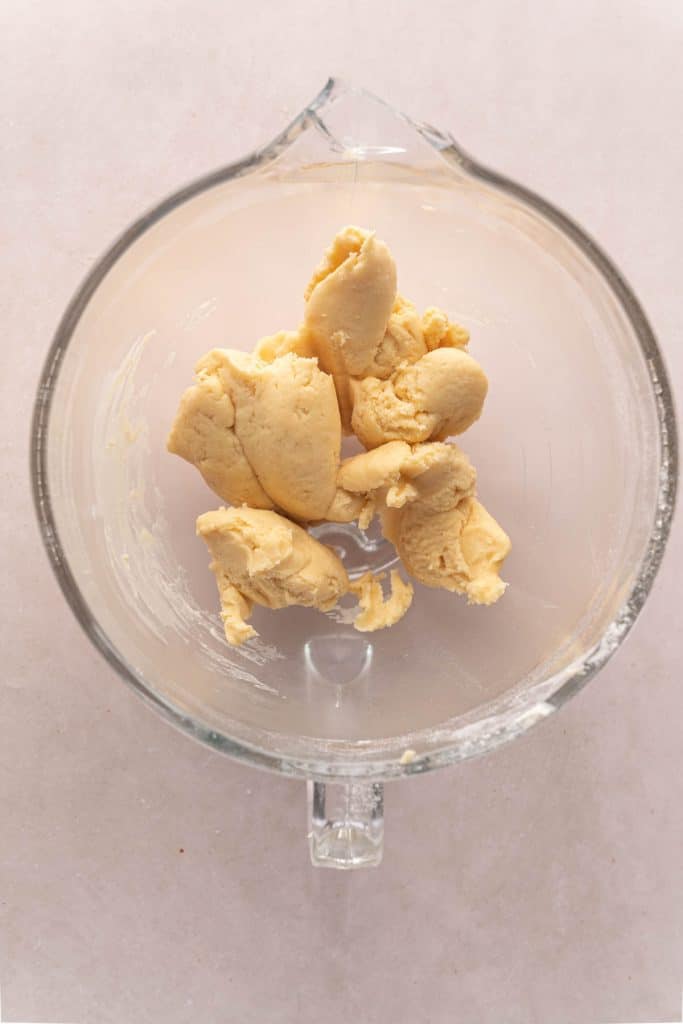
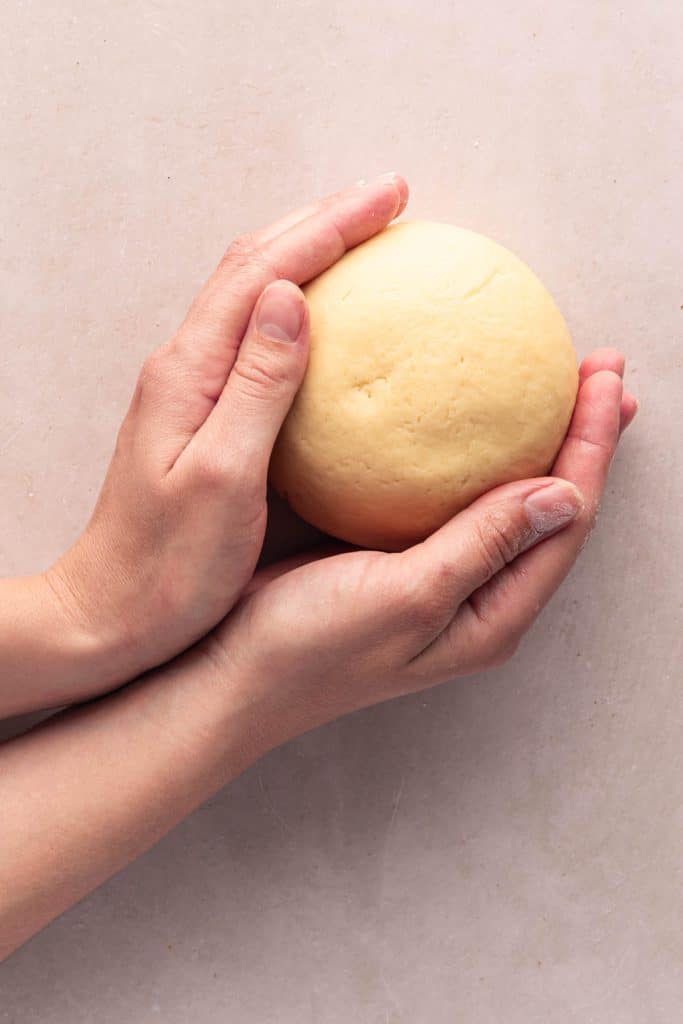



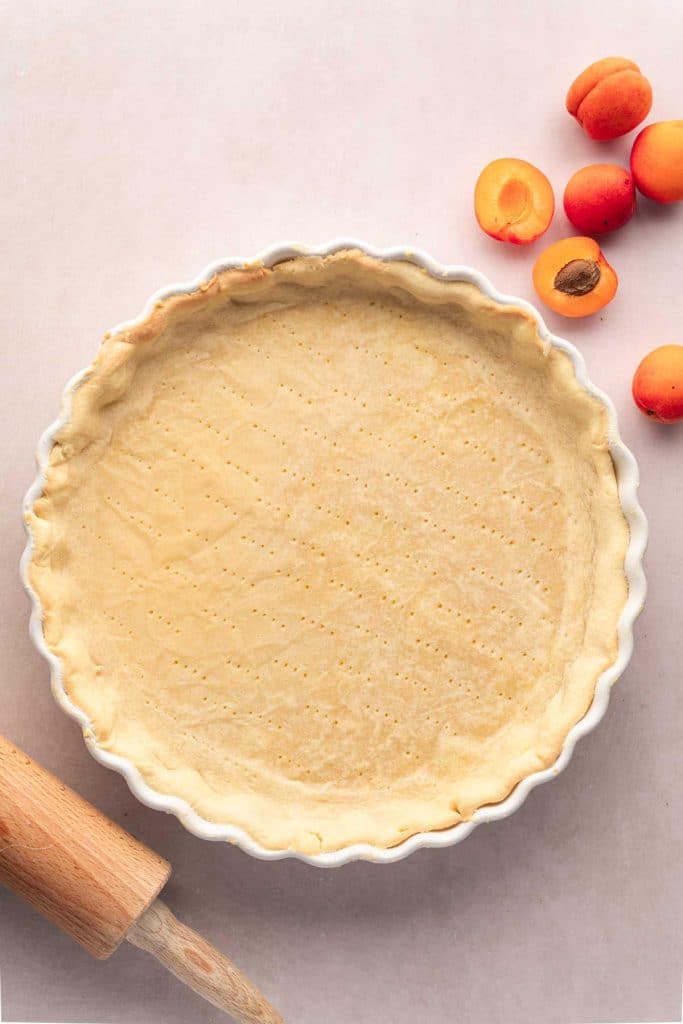
Géraldine’s Tips
- Be careful not to overwork the dough to avoid developing too much gluten.
- Ensure you work on a clean work surface to maintain the sweet shortcrust pastry dough’s cleanliness and prevent any unwanted debris from getting mixed in.
- Remember the importance of resting the dough before rolling it out and before prebaking. This relaxes the gluten and prevents the dough from shrinking while rolling or baking.
- For an even better hold of the pastry crust, consider brushing it with egg white before filling or sprinkling ground almonds on the bottom of the crust. The ground almonds help absorb fruit juices, preventing a soggy crust.
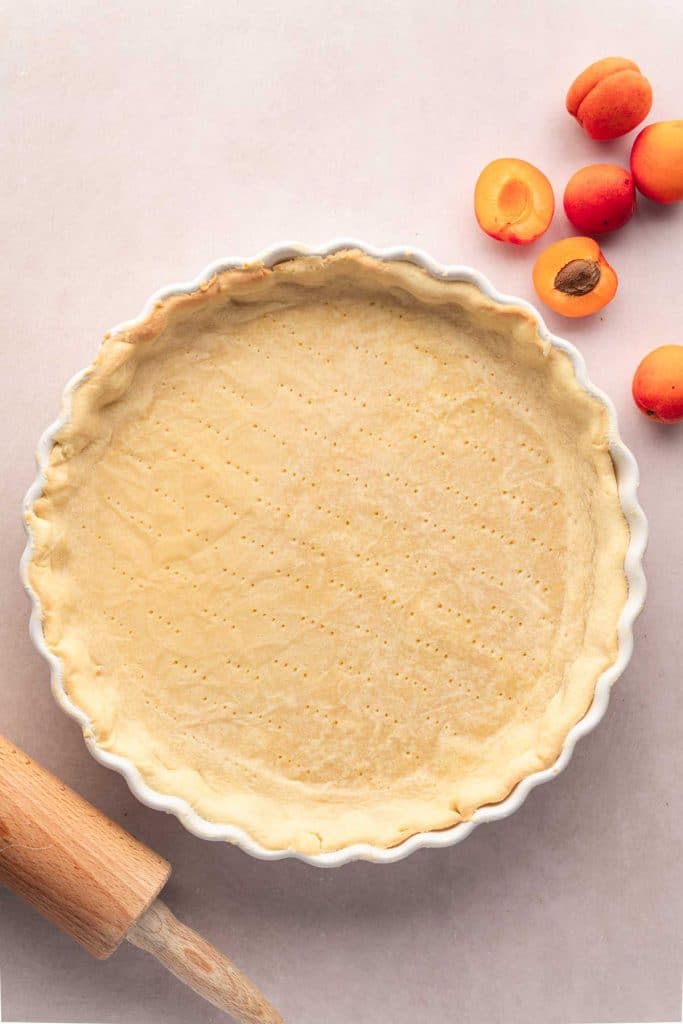
Variation Ideas
Here are some variations to give you sweet shortcrust pastry a little twist!
- Cocoa powder: For a chocolate-flavored crust (perfect with raspberries or pears), add 1 or 2 tablespoons of cocoa powder along with the dry ingredients. You may need to add a few extra drops of water.
- Lemon zest: Incorporate lemon zest into the dough for a refreshing citrusy flavor. Rub the zest of one lemon with the sugar before adding it to the dough.
- Cinnamon: Sprinkle a pinch of cinnamon into the dough to infuse the crust with a cozy and aromatic note.
- Vanilla: Add a hint of vanilla by adding 1 teaspoon of vanilla extract when mixing the dough.
FAQ: Sweet Shortcrust Pastry
Shortcrust pastry consists of a single layer of smooth dough and is generally used to make tarts with stone fruits and quiches (without sugar).
Pâte sucrée or pâte sablée is made with more sugar and the addition of an egg. In the pâte sucrée, part of the flour is replaced with ground almonds and the sugar with icing sugar. Both are crumbly and sweeter and are used for tarts with berries.
Yes, the sweet shortcrust pastry dough can be frozen for later use. After wrapping the dough in plastic wrap, place it in a freezer-safe bag or container. Thaw the frozen dough in the refrigerator overnight before rolling it out and baking.
Absolutely! The sweet shortcrust pastry can be prepared in advance. Once you’ve formed the dough into a ball and wrapped it in plastic wrap, refrigerate it for up to 2 days before rolling it out and baking. This allows you to save time when you’re ready to use it for your sweet treats.
To prevent a soggy crust, it is important to blind bake the pastry before adding the filing. You can also brush it with egg white for a protective layer. I also like to. add a layer of ground almonds to absorb any excess moisture from juicy fillings. These steps help maintain the crispness of the pastry.
Don’t hesitate to leave me a comment, it always makes me happy!

You can also find me on Instagram, Facebook and TikTok to see behind the scenes of my blog
Sweet Shortcrust Pastry (pâte brisée sucrée)
Click on the stars to rate!
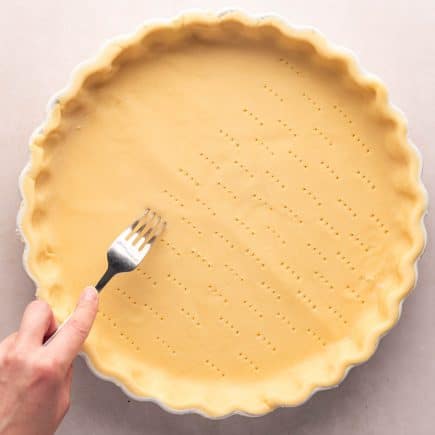
Ingredients
- 2 cups flour 250 g
- 1/2 cup butter 125 g – 4,5 oz
- 1/4 cup sugar 50 g
- 1/4 cup cold water 60 ml or one whole egg
Instructions
- In a large bowl, combine flour and sugar.
- Cut the butter into small pieces and add to the bowl.
- Using your fingers or food processor, blend the butter into the flour mixture until the dough resembles sand.
- Gradually add cold water, a little at a time, while mixing until the dough holds together. Be careful not to overwork the dough. Form into a ball. Wrap in plastic wrap.
- Let the dough rest for at least 30 minutes or place in the freezer for 10-15 minutes to firm up and become easier to handle.
- Preheat your oven to 180°C.
- On a lightly floured surface, roll out the dough to fit the desired tart pan or tartelette mold.
- Carefully transfer the rolled-out dough to the greased, parchment-lined tin, pressing gently into the bottom and up the sides.
- Prick the dough with a fork.
- Using a rolling pin or a sharp knife, trim off any excess dough from the edges of the dish.
- Cover the dough with parchment paper and fill with pie weights, dried beans or uncooked rice to prevent it from puffing up during blind baking.
- Bake the pastry in the preheated oven for 10-15 minutes.
- Remove parchment paper and weights. Leave to rest on a wire rack while you prepare the rest of the recipe.
